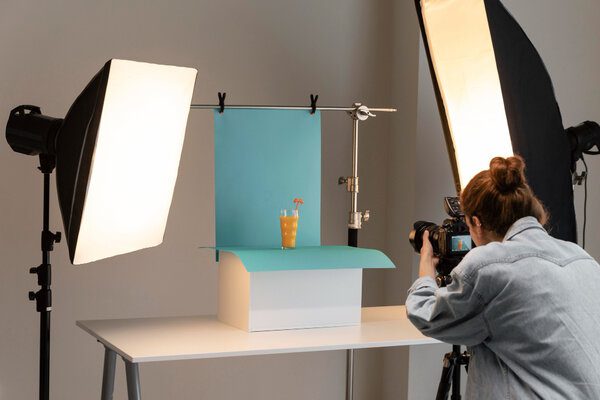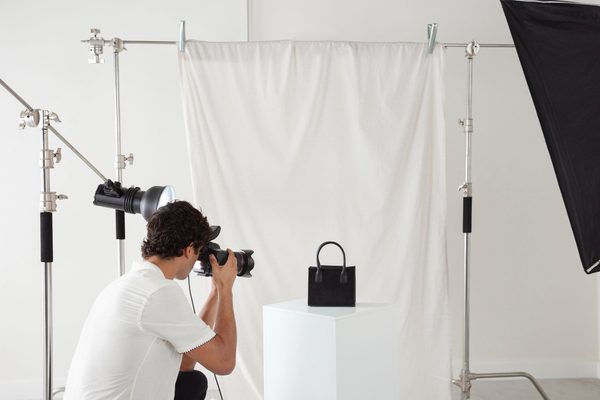If you’re like most photographers then you might be figuring out how much to charge for ecommerce photography. You might wonder if your rates are too high, driving clients away, or too low, leaving you underpaid.
I’ve been there too, and trust me, you’re not alone in this struggle.
Setting the right price is really important. Not just for your business but for your confidence as a professional.
If your rates are fair and reflective of your skill then it’s easier to explain them to potential clients. Plus, pricing your work correctly shows you value your time, expertise, and effort.
In this guide, I’ll break down everything you need to know about pricing ecommerce photography. I will share how to determine your costs and analyze market trends. Also, I’ll walk you through practical steps to help you set rates that work for you.
How much to charge for ecommerce photography? – Factors
Factors to Consider When Pricing Ecommerce Photography
When figuring out how much to charge for ecommerce photography, there’s no one-size-fits-all answer. Instead, your pricing depends on several factors.
You can set rates that make sense for your business while staying competitive in the market by understanding these.
1. Understanding Your Costs
One of the first things to consider is your expenses. Ecommerce photography is not just about taking pictures. It’s also about the tools and resources you invest in to deliver high-quality results.
Here are some costs to keep in mind:
- Equipment: Cameras, lenses, lighting, and tripods are essential for ecommerce photography. These tools aren’t cheap, and regular maintenance or upgrades can add to your expenses.
- Software and Editing Tools for Ecommerce Photography: Adobe Photoshop, Adobe Lightroom, and other editing tools are critical for post-production. Most of these come with monthly or annual fees.
- Studio Rent or Setup: If you’re renting a studio or have a dedicated space at home then that cost needs to be factored into your pricing.
You can ensure your rates cover your costs and leave room for profit by knowing your total expenses. Skipping this step can lead to underpricing. This might hurt your business in the long run.
For more tips on managing photography expenses, check out this helpful video on how to budget for photography gear:
2. Time Investment
Time is money, especially in photography. You’re not just charging for the time spent shooting. But you also need to account for editing, revisions, and delivering the final product.
Let’s break it down:
- Shooting Time: This includes everything from setting up your equipment to capturing the photos. Product photography can take hours, depending on the number of items and complexity of the shoot.
- Editing Time: Post-production is where the magic happens. But it’s also time-intensive. Correcting colors, adjusting lighting, and retouching images take skill and patience.
- Revisions: Many clients request edits, and these revisions take time. Make sure you build this into your pricing to avoid surprises.
Consider how much time you’re putting into each project when setting your rates. This ensures you’re compensated fairly for your efforts.
3. Your Experience Level
Your experience plays a big role in determining how much you can charge. If you’re just starting then your rates might be lower to attract clients and build your portfolio.
You can justify charging more as you gain experience and expand your portfolio.
- Beginners: If you’re new to ecommerce photography then focus on offering competitive rates while building your skills. Because clients are more likely to take a chance on affordable beginners.
- Experienced Photographers: If you have years of experience and a strong portfolio then clients will pay more for your expertise and consistent quality.
Your portfolio acts as proof of your capabilities. High-quality examples of product photos, lifestyle images, and other ecommerce shots can help justify your pricing to clients.
What Is Ecommerce Photography? A Simple Guide for Online Sellers
4. Industry Standards and Market Trends
Knowing what others in the industry charge can help you set competitive rates. Researching industry trends and pricing benchmarks ensures your rates are aligned with the market.
- Average Rates: Look at what other photographers in your niche and location are charging. Rates can vary based on experience, location, and project complexity.
- Location: Your geographical area affects how much clients are willing to pay. For example, rates in large cities are typically higher than in smaller towns.
5. Client Needs and Expectations
Different clients have different needs, and your pricing should reflect that. Some projects may require additional work. Such as lifestyle shots, custom props, or specialized setups.
- Types of Ecommerce Shoots: Standard product shots, lifestyle images, and 360-degree spins all require varying levels of effort.
- Customization: If clients request props, specific backgrounds, or models, these additional elements should be priced accordingly.
The key here is to communicate clearly with clients about their expectations. This helps you provide accurate quotes and avoid misunderstandings.
How to take product photos for ecommerce according to experts
Common Pricing Models for Ecommerce Photography
Once you’ve considered all the factors above, the next step is deciding how to structure your pricing. Let’s look at four common models:
1. Per Image Pricing
Charging per image is one of the simplest ways to price ecommerce photography.
- How It Works: You set a fixed rate per photo. Clients pay based on the number of images they need.
- When to Use It: This model works well for clients who need a specific number of high-quality images.
- Pros and Cons: It’s easy for clients to understand, but it can be limiting if a project requires extra effort. Such as multiple revisions or extensive editing.
2. Hourly Rates
Some photographers prefer to charge by the hour. Especially for smaller projects or shoots with uncertain timelines.
- How to Calculate: Add up your total expenses, factor in your desired hourly wage, and divide by your estimated hours per project.
- Benefits: Hourly rates work well for projects with unpredictable requirements. Such as last-minute changes or extra shots.

3. Flat Project Fees
Flat fees are ideal for larger projects with defined deliverables.
- How It Works: You quote a single price for the entire project, covering everything from shooting to editing.
- Why Clients Love It: Predictable pricing makes it easier for clients to budget.
4. Retainer Agreements
If you have long-term clients then offering a retainer agreement can ensure consistent income.
- When to Use It: Retainers work best for clients who need regular photography services. Like monthly product updates.
- Benefits: You get financial stability, while clients enjoy prioritized scheduling and discounted rates.
How Much Should You Charge for Ecommerce Photography? Step by Step
Figuring out how much to charge for ecommerce photography can feel tricky. But breaking it down step by step makes it easier.
Here’s what you need to know about pricing benchmarks, specific project types, and real-world examples.
1. Pricing Benchmarks and Averages
It helps to compare your pricing with industry benchmarks when deciding your rates. Rates can vary based on skill level and location.
- Beginner photographers typically charge $20–$50 per image or $50–$100 per hour. They focus on building their portfolio and gaining experience.
- Mid-level photographers charge $75–$200 per image or $100–$300 per hour. They offer a solid balance of skill and value.
- Expert photographers charge $250 or more per image or $300–$500+ per hour. They have extensive portfolios and high-demand skills.
Location also plays a role. Urban areas often have higher rates due to greater demand. On the hand rural photographers may face more competition on pricing.
If you’re curious about rates in your area then consider checking online communities like Photographers of America. You can also check local Facebook groups for insights into average ecommerce photography rates.
Need Help With Ecommerce Image Editing? Contact Us!
2. Pricing for Specific Types of Ecommerce Photography
Different styles of ecommerce photography come with unique pricing structures. Here’s a quick guide to some popular options:
- Product-only shots (white background): These are the most common and cost-effective. Typical rates range from $20–$100 per image depending on volume.
- Lifestyle and creative photography: Since these shoots involve props, styling, or models, the price is higher. Expect to charge $100–$500 per image.
- 360-degree photography: This is a niche service that requires specialized equipment. Rates range from $150–$500 per product depending on the number of images needed for the full rotation.
These pricing variations show why it’s important to factor in client expectations and the work involved.
Why Pricing Ecommerce Photography Matters
Did you know that over 90% of online shoppers say visuals play a big role in their buying decisions? Quality ecommerce photography is what makes products pop off the screen.
Your work directly influences how well products sell. Think about it: Would you buy a product with a poorly lit or blurry image? Probably not.
Professional product photos build trust and make products look irresistible. Take Amazon, for example. Sellers with clean and professional images tend to rank higher and sell more.
This proves that ecommerce product photography isn’t just about aesthetics. It’s about boosting sales.
Your work helps clients grow their businesses as a photographer. So, when setting your prices remember that you’re offering more than images. You’re offering value that can drive results.

Undervaluing Your Work Hurts Everyone
It’s tempting to charge less when you’re starting out. But here’s the truth: undervaluing your work can hurt both you and the photography market.
If you charge too little then you’ll struggle to cover your costs and may feel burnt out quickly. Worse, you might send the wrong message that ecommerce photography isn’t worth investing in.
Let me give you an example. Imagine charging $5 per image for a project that requires hours of setup, shooting, and editing.
You’re essentially working for less than minimum wage! Over time, this devalues not just your work but also the efforts of other photographers in the industry.
That’s why charging fair rates isn’t just about you. It’s about maintaining industry standards.
When you price your services correctly you position yourself as a professional. Clients will respect you more. You’ll also attract serious businesses willing to pay for quality.
(If you’re struggling with pricing, this article on how to set photography rates can give you more clarity.)
Now that we’ve talked about why pricing matters and how it impacts both your business and the industry. Let’s move on to the next step. Examples for determining how much to charge for ecommerce photography.
Ready? Let’s dive in!
Pricing Examples for Ecommerce Photography
To give you a clearer picture, here are two examples of how pricing works in real-life scenarios:
Example 1:
A small product shoot for 10 items with basic white-background images.
- Rate per image: $50
- Total cost: $500
- Time investment: 5 hours (including shooting and editing)
Example 2:
A large ecommerce project with 100+ items that includes creative shots and lifestyle images.
- Creative shots: $150 per image (20 images = $3,000)
- Product-only shots: $50 per image (80 images = $4,000)
- Total cost: $7,000
These examples highlight how volume and complexity affect pricing.
How to color match images for eCommerce: Complete Guide
Tools and Resources for Pricing Ecommerce Photography
Getting your pricing right often means using the right tools and resources. Here’s how you can simplify the process.
1. Photography Pricing Calculators
Pricing calculators help you figure out rates based on costs, time, and profit margins. Some popular tools include:
- NPPA Cost of Doing Business Calculator: Perfect for understanding your expenses and profit goals.
- Toggl: Helps track your time and calculate rates accordingly.
These tools take the guesswork out of pricing.
2. Templates for Quoting Clients
A professional quote makes you look credible and organized. Make sure to include:
- A breakdown of your services (shooting, editing, revisions, etc.)
- Your rates (per image or hourly)
- Delivery timelines
You can find free quote templates on platforms like HoneyBook or Proposify to get started.
3. Online Communities and Forums
Joining online groups lets you learn from other photographers and get advice on pricing.
Popular eCommerce photography communities include:
Sharing experiences with peers is one of the best ways to improve your pricing strategies.

How to Communicate Your Ecommerce Photography Rates to Clients
Once you’ve figured out how much to charge for ecommerce photography, the next step is sharing your rates confidently with clients.
Building Confidence in Your Pricing
It’s normal to feel nervous about quoting rates, but confidence comes with practice.
Remember, your work has value. Practice your pitch, and be ready to explain how your pricing reflects the quality of your services.
Handling Client Objections
Clients may push back on pricing but that’s okay. You can respond by explaining your costs, time investment, and the benefits of professional ecommerce photography.
For example, highlight how quality photos can increase their sales.
Upselling and Offering Add-Ons
Boost your income by offering extra services, like faster delivery or additional editing. For example, you can charge an extra $20–$50 per image for express delivery or advanced retouching.
How to Edit Photos for Ecommerce That Boost Conversions
Tips to Maximize Your Earnings as an Ecommerce Photographer
Offer Packages and Bundles
Creating package deals is a great way to attract clients and increase your revenue. Many clients prefer bundled pricing because it simplifies decision-making and saves money compared to individual services.
For example, you can offer a package that includes 10 product-only shots, 5 lifestyle images, and basic retouching for a flat fee.
Another idea is bundling a “starter pack” for new ecommerce businesses. This might include white-background shots and a few 360-degree images.
Package deals make your services look more professional and encourage clients to book more work at once. You can also offer add-ons, like faster delivery or extra edits, to further boost your income.
Streamline Your Workflow
Time is money, especially when you’re balancing multiple projects. To maximize your earnings you should invest in tools and processes that save you time.
Software like Adobe Lightroom presets for editing. Batch-editing tools can also speed up your workflow.
Consider using online client management systems like HoneyBook or Studio Ninja to organize your schedule and streamline invoicing.
You should automate repetitive tasks. Such as resizing images for specific marketplaces can also reduce your workload. The less time you spend on each project, the more projects you can take on. That means more income.
Market Yourself Effectively
Marketing is key to getting consistent bookings as an ecommerce photographer. Start by building a strong portfolio on platforms like Behance or Squarespace to showcase your work.
Share before-and-after shots on social media to highlight your editing skills, and use hashtags like #ecommercephotography to reach potential clients.
Client referrals can also boost your bookings. Also, offer a small discount or bonus image for returning customers who refer new clients to you.
Positive reviews on your website or Google Business profile can further establish trust with new clients.
Check Out 👉🏻 Top Professional Ecommerce Image Editing Services To Date!
Conclusion
Setting your rates as an ecommerce photographer doesn’t have to be overwhelming.
Start by understanding your costs, researching average pricing, and testing different strategies to see what works for you.
Remember to value your time and skills. You deserve to be compensated fairly for your hard work.
If you’re ready to put these tips into action, use the tools and templates mentioned in this guide to get started. Confident pricing helps you attract better clients and build a sustainable career.
Ready to set your rates? Use the tips and tools in this guide to price your ecommerce photography like a pro!
FAQs About “How much to charge for ecommerce photography?”
How do I calculate my hourly rate for photography?
To calculate your hourly rate you can start by determining your desired monthly income. Divide that by the number of hours you plan to work each month. Add costs like equipment, editing software, and travel expenses. This ensures your rate covers your time and overhead costs.
What should I include in my photography contracts?
Your contracts should include key details like project scope, pricing, timelines, and usage rights. Specify how many edits the client can request and include a section for handling cancellations or delays. A clear contract protects both you and the client.
How much should I charge for bulk product photography?
Bulk pricing typically offers discounts for larger orders. For example, you might charge $20 per image for smaller shoots but drop that to $15 per image for 50 or more products. Adjust your rates to reflect the time and resources required for larger projects.


